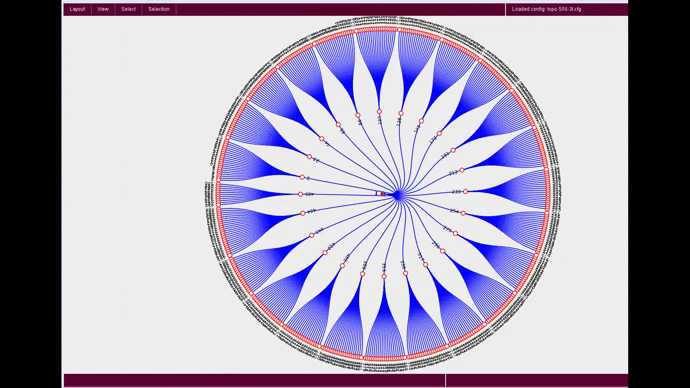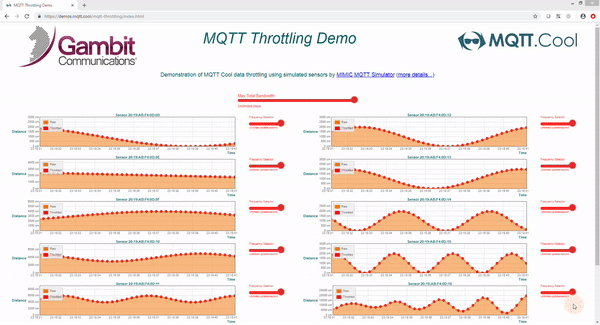MIMIC MQTT Simulator
![]() is an optional MIMIC protocol module that allows to simulate large
environments of MQTT-based sensors, actuators, gateways, etc.
is an optional MIMIC protocol module that allows to simulate large
environments of MQTT-based sensors, actuators, gateways, etc.
It can be enabled after the base MIMIC installation as below.
-
At this point you should have MIMIC installed, and the MIMICview GUI
running
(see details)
 . If you don't have MIMICview running, please consult your license e-mail
to get it installed and running.
. If you don't have MIMICview running, please consult your license e-mail
to get it installed and running.
-
Check whether you already have MQTT enabled in MIMIC as shown in the
Help -> About Mimic... dialog in MIMICview. It should be listed
under Loaded protocols. If already there, then skip to step 7.
-
Run Protocol Wizard using the Wizards -> Protocol Wizard menu in
MIMICView
(see details)

-
Select MQTT Simulator in the Select Protocols dialog
if not already selected. Press Next.
-
Supply corresponding license keys from the license email in the
Supply License Keys dialog. Then press Next.
-
The Result Installing/Uninstalling Protocols dialog shows
what got done. Press Finish to proceed. When the
simulator restarts, you should have MQTT enabled.
Download optional sample MQTT packages
-
At this point, you should have MQTT enabled in MIMIC as shown in the
Help -> About Mimic... dialog in MIMICview. It should be listed
under Loaded protocols. If not, send us the MIMIC log.
(see details)

-
Invoke the MIMICview Wizard -> Update menu to download and
install MQTT packages
(see details)

-
Check under the section Collections for MQTT Packages.
If not there, then it is already installed. Else, select it, and
press Next to install.
Firewall permission for www.gambitcomm.com , port 80 is needed to run the Update Wizard over the web.
Please visit this link for alternative MIMIC update instructions in case you don't have Internet to use the Update Wizard over the web connection on the MIMIC system:
http://www.mirror1.gambitcommunications.com/update/mibs/mimic-update-xxxx/
where xxxx is current MIMIC version e.g., 1900
Configure a sensor
The simplest scenario is to have a sensor simulated in MIMIC publish telemetry to a public MQTT broker
 or open MQTT broker on your intranet. If so, follow the next
steps, else if unsure, you may want to first check our
MQTT Compatibility page
or open MQTT broker on your intranet. If so, follow the next
steps, else if unsure, you may want to first check our
MQTT Compatibility page
 to verify instructions for the platforms we have already tried.
to verify instructions for the platforms we have already tried.
-
After the installation is complete, load the lab configuration
mqtt-bosch1.cfg using the MIMICview File -> Open menu.
(see details)

-
To publish data from the configured sensor, select agent 1 and invoke
Edit -> Configure -> All dialog. Set the IP Address
to an address that will work in your LAN.
(see details)
 .
If in doubt, set the address to be the same as your network interface
IP address.
.
If in doubt, set the address to be the same as your network interface
IP address.
-
In the MQTT tab, set the Broker Address to the IP
address where you have your broker listening for messages. This must
be a network IP address, eg. a public broker, or your own MQTT broker,
not the loopback address 127.0.0.1. Keep others as they are. Click
Ok to apply the changes.
-
When you start the sensor with Agent -> Start then it starts
publishing messages to your broker.
-
Verify with a MQTT subscriber client like
mosquitto_sub
 .
.
More
-
This 4-minute video shows how to change the payload of the MQTT sensor
https://www.youtube.com/watch?v=O3CdYaYtpc8&hd=1

-
This 2-minute video shows how to get 1000 sensors configured from scratch:
https://www.youtube.com/watch?v=kV6wqe2U60A&hd=1

Follow along by pausing the video at each step.
The view type of the sensors might look unfamiliar to you. If you are in Explorer View
 ,
then use View -> Type -> Classic to switch to Classic view.
,
then use View -> Type -> Classic to switch to Classic view.
-
Please invoke Help -> Contents menu and refer to section
Optional Protocol Modules -> MIMIC MQTT Protocol Module Guide
for full details, or
access it here
 .
It has all the technical details, including compatibility to 3rd party
software that we have tried in the Compatibility section.
.
It has all the technical details, including compatibility to 3rd party
software that we have tried in the Compatibility section.
Enable MQTT in MIMIC


